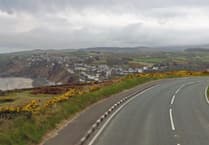Have you seen your first swift of the year yet?
These amazing birds have just started to arrive on the island, having flown hundreds of miles from southern Africa at a cruising speed of 22mph, often covering more than 200 miles a day.
Not bad going for such small birds.
They either cross the Sahara or navigate their way along the coastline of Africa.
Once they’ve survived this challenge they begin their journey over Spain, climbing high over the Pyrenees and travelling through western France before hitting UK soil.
These little birds spend most of their lives on the wing – they catch insects in the air, and drink by swooping low over water to take a sip.
They even sleep while flying (the only bird known to do this). Flying at a high altitude of 10,000 feet (the same as a small plane) seems to help them navigate while they are asleep, using wind drift and automatically adjusting their flight to stay on a specific course.
Swifts have the perfect bodies for being airborne for so long, with their long wings and slender bodies.
Nor are they encumbered by long legs (in fact their legs are so short they can’t take off from the ground) or tail feathers, which is the best way to tell them apart from swallows.
Swallows have long tail streamers, red throats and glossy blue-black backs, and although similar in appearance to the swift they are completely unrelated.
They are known as the ‘bird of freedom’ because they cannot endure captivity and will only mate in the wild.
The house martin can be identified by its slightly curved tail, and by its white underbelly and rump which can just about be glimpsed as the bird flashes by in its mission to catch insects.
Swallows, swifts and house martins traditionally nested in cliffs, caves and hollow trees, but they have adapted to urban environments and they will make their nests under the eaves of buildings.
Their nests are carefully crafted out of mud and are cup or oval shaped, but sometimes they break apart, or sometimes a hatchling can slip over the edge.
If you find a hatchling on the floor and you can’t put it back in the nest, pop it in an empty margarine tub and place it as high up as possible (out of the reach of cats) so that the parents can continue to feed it.
All birds, their nests, eggs and young are protected by law (the Wildlife Act 1990) and it is an offence to:
*Intentionally or recklessly kill, injure or take any wild bird
*Intentionally or recklessly take, damage or destroy the nest of any wild bird whilst it is in use or being built
*Intentionally or recklessly take or destroy the egg of any wild bird
*Intentionally or recklessly disturb any wild bird while it is nest building, or at a nest containing eggs or young, or disturb the dependent young of such a bird.
The maximum penalty that can be imposed for a wildlife crime like this – in respect of a single bird, nest or egg – is a fine up to £10,000.
Unintentional disturbance of nest sites can occur when builders are undertaking roof works, or when farmers and gardeners are removing vegetation such as hedges and bramble patches.
During the bird nesting season, from now until late September, all buildings and vegetation should be checked first for nesting birds before any work is undertaken.
Please also spare a thought for hedgehogs if you’re planning to remove vegetation, particularly if you’re strimming or mowing through long grass or hedges.
Many hedgehogs are killed by cutting machines every year, and so make plenty of noise and poke about with a stick so that a sleepy hog has the chance to run away.





Comments
This article has no comments yet. Be the first to leave a comment.